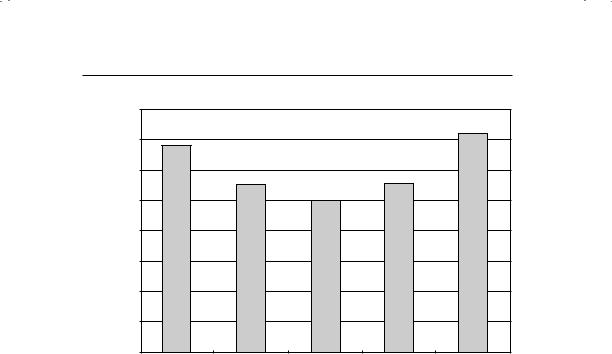
aswath_damodaran-investment_philosophies_2012
.pdf
510 |
INVESTMENT PHILOSOPHIES |
may be commodities, currencies, fixed income, or arbitrage) found some evidence (albeit not overwhelming) of market timing payoff in bond and currency markets but none in equity markets.27 In contrast, a more recent and comprehensive evaluation of just 221 market timing hedge funds found evidence that a few of these funds are able to time both market direction and volatility, and generate abnormal returns as a consequence.28
Building on the theme of liquidity, there is also evidence that what separates successful hedge funds from those that fail is their capacity to adjust market exposure ahead of market liquidity changes, reducing exposure prior to periods of high illiquidity. The funds that do this best outperform funds that don’t make the adjustment by 3.6 to 4.9 percent a year after adjusting for risk.29
I n v e s t m e n t N e w s l e t t e r s
There are hundreds of investment newsletters that investors subscribe to for sage advice on investing. Some of these investment newsletters are centered on suggesting individual stocks for investors, but some are directed toward timing the market. For a few hundred dollars, we are told, we too can be privy to private signals of market movements.
Graham and Harvey examined the market timing abilities of investment newsletters by examining the stock/cash mixes recommended in 237 newsletters from 1980 to 1992.30 If investment newsletters are good market timers, you should expect to see the proportion allocated to stocks increase prior to the stock market going up. When the returns earned on the mixes recommended in these newsletters are compared to a buy-and-hold strategy, 183 or the 237 newsletters (77 percent) delivered lower returns than the buy-and-hold strategy. One measure of the ineffectuality of the market timing recommendations of these investment newsletters lies in the fact that while equity weights increased 58 percent of the time before market upturns, they also increased by 53 percent before market downturns. There is some evidence of continuity in performance, but the evidence is much stronger
27Y. Chen, “Timing Ability in the Focus Market of Hedge Funds” (working paper, Boston College, 2005).
28Y. Chen and B. Liang, “Do Market Timing Hedge Funds Time the Market?”
Journal of Financial and Quantitative Analysis 42 (2007): 827–856.
29C. Cao, Y. Chen, B. Liang, and A. Lo, “Can Hedge Funds Time Market Liquidity?” (SSRN Working Paper 1537925, 2011).
30John R. Graham and Campbell Harvey, “Market Timing Ability and Volatility Implied in Investment Newsletters’ Asset Allocation Recommendations,” Journal of Financial Economics 42 (1996): 397–421.

The Impossible Dream? Timing the Market |
511 |
for negative performance than for positive performance. In other words, investment newsletters that give bad advice on market timing are more likely to continue to give bad advice than are newsletters that give good advice to continue giving good advice.31
The only hopeful evidence on market timing comes from a study of professional market timers who are investment advisers. These timers provide explicit timing recommendations only to their clients, who then adjust their portfolios accordingly—shifting money into stocks if they are bullish and out of stocks if they are bearish. A study by Chance and Hemler looked at 30 professional market timers who were monitored by MoniResearch Corporation, a service that monitors the performance of such advisers, and found evidence of market timing ability.32 It should be noted that the timing calls were both short term and frequent. One market timer had a total of 303 timing signals between 1989 and 1994, and there were, on average, about 15 signals per year across all 30 market timers. Notwithstanding the high transaction costs associated with following these timing signals, following their recommendations would have generated excess returns for investors.33
M a r k e t S t r a t e g i s t s
The market strategists at major investment banks represent perhaps the most visible symbols of market timing. Their prognostications about the market are widely disseminated not only by their investment banks but also by the media. While much of what market strategists say about markets cannot be easily categorized as bullish or bearish—good market strategists are difficult to pin down when it comes to explicit forecasts—they also make specific recommendations on preferred asset allocation mixes that are made public.
Given that this is the primary mission of market strategists, how do these allocation mixes yield market predictions? One way is to look at the percentage allocated to stocks. More bullish market strategists will recommend a larger proportion of the portfolio be invested in stocks, whereas bearish strategists will overweight cash and bonds. The other is to look at changes in
31A good market timing newsletter is likely to repeat its success about 50% of the time. A poor market timing newsletter has a 70% chance of repeating its poor performance.
32D. M. Chance and M. L. Hemler, “The Performance of Professional Market Timers: Daily Evidence from Executed Strategies,” Journal of Financial Economics
62(2001): 377–411.
33The study looked at excess returns after transactions costs but before taxes. By its very nature, this strategy is likely to generate large tax bills, since almost all of your gains will be taxed at the ordinary tax rate.

512 |
INVESTMENT PHILOSOPHIES |
|
|
16.00% |
|
|
14.00% |
|
1992–2001 |
12.00% |
|
10.00% |
||
|
|
|
Return, |
|
8.00% |
|
6.00% |
|
Annual |
|
|
|
4.00% |
|
|
|
2.00% |
|
|
0.00% |
Best Market |
Average Market |
Worst Market Robot Blend 100% Equity |
Strategist |
Strategist |
Strategists |
F I G U R E 1 2 . 9 Annual Return from Market Strategies Mixes, 1992–2001
Source: Wall Street Journal.
holdings recommended by the same strategist from period to period—an increase in the proportion allocated to stocks would indicate more bullishness. On both dimensions, the market timing skills of strategists are questionable. The Wall Street Journal, in addition to reporting the asset allocation mixes of strategists, also compares the returns that would have been generated by following each bank’s allocation advice to the returns you would have made by being fully invested in stocks over 1-year, 5-year, and 10-year periods. To counter the argument that it is unfair to compare a 100 percent equity portfolio to a asset allocation mix, the Journal also reports on the returns on a robot mix—a fixed allocation across stocks, bonds, and bills. Figure 12.9 summarizes the returns on all three from 1992 to 2001, as well as the returns you would have earned by following the strategist who had the best mixes over the period and the one with the worst mixes.
Note that the returns on the robot mix are slightly higher than the average returns generated by following the average market strategists. Of the 16 banks that the Wall Street Journal tracks, only five would have generated returns higher than the robot mix over the period, and even those would have been well within a statistical margin for error. Finally, even the best strategist’s asset mix would have underperformed a strategy of being fully invested in stocks. Overall, the evidence indicates that the market timing skills of leading market strategies are vastly overstated.



The Impossible Dream? Timing the Market |
515 |
preferences) to markets that you believe are undervalued and less than you normally would to markets that are overvalued. The second approach is to switch investment styles and strategies within a market (usually stocks) to reflect expected market performance. The third is to shift your funds within the equity market from sector to sector, depending on your expectations of future economic and market growth. The fourth and most risky way to time markets is to speculate on market direction, using either borrowed money (leverage) or derivatives to magnify profits.
A s s e t A l l o c a t i o n The simplest way of incorporating market timing into investment strategies is to alter the mix of assets—stocks, cash, bonds, and other assets—in your portfolio. In fact, we judged the capacity of mutual fund managers and investment newsletters to time the market by looking at whether changes that they recommended in the asset allocation mix were useful predictors or future market movements. The limitation of this strategy is that it can be costly to alter holdings in individual asset classes, since you may have to liquidate assets in one class and invest in assets in another. It can also take time to put into practice. As a consequence, asset allocation works better with long-term than with short-term market timing.
S t y l e S w i t c h i n g There are some investment strategies that do well in bull markets and others that do better in bear markets. If you can identify when markets are overvalued or undervalued, you could shift from one strategy to another or even from one investment philosophy to another just in time for a market shift.
For instance, in our discussion of growth versus value strategies in Chapter 9, we noted the research done by Richard Bernstein, which showed that growth investing does better that value investing when earnings growth is low for the entire market and that value investing beats growth investing when earnings growth is high. Bernstein also notes that growth investing tends to do much better when the yield curve is flat or downward sloping. In a related result, Pradhuman presents evidence that small cap investing yields higher returns than value investing when inflation is high and bond default spreads are low. You could take advantage of your market timing skills to shift from growth to value investing if you believe that markets are overvalued and headed for a correction, or from value to growth investing if you consider them undervalued and likely to go up. In a paper that examines the payoff to style timing, Kao and Shumaker estimate the returns an investor would have made if she had switched with perfect foresight from 1979 to 1997 from value to growth stocks and back for both small-cap and

516 |
INVESTMENT PHILOSOPHIES |
large-cap stocks.35 The annual returns from a perfect foresight strategy each year would have been 20.86 percent for large-cap stocks and 27.30 percent for small-cap stocks. In contrast, the average annual return across all stocks was only 10.33 percent over the period.
While this strategy looks promising, there may be less to it than meets the eye. In addition to the higher transaction costs and taxes that come with switching from one investment style to another, you also have the problem that most switches occur after the fact, reflecting not market timing skills but reaction to market performance. Thus, value investors seem to switch to growth investing after a market slowdown has occurred and not in advance of a slowdown, and growth investors switch to value investing well into a bull market. If, in fact, if you do have skills as a market timer that make you confident enough to switch investment styles, you could argue that you would get a much bigger payoff by speculating, using index futures or options.
S e c t o r R o t a t i o n There are some investors who believe that staying out of the market because of their views on the market—that it is either too costly (because of the possibility that they could be wrong) or not feasible (because they are required to invest in the market). They may be able to parlay their market timing skills into superior returns by switching across sectors of the market as their view of the market changes. Thus, if they believe that the market will increase in the coming periods, due to stronger than expected real economic growth, they may switch into cyclical sectors. Alternatively, if their view is that interest rates will go up in the coming year and this will cause the market to drop, they may switch out of financial stocks into companies that are less sensitive to interest rates (e.g., consumer products).
While there are undoubtedly differences across sector rotation models, Stovall provides an excellent summary of the conventional wisdom on which sectors do best at each stage of the market in his book on sector rotation.36 Figure 12.10 is extracted from his book.
Note that the market lead is captured by the fact that the market both bottoms out and peaks before the economy. Your sector bets reflect this leading effect. You invest in cyclicals as the economy enters a recession (and the market hits bottom) and you shift into industrial and energy companies as the economy improves. If you can pick the right sectors to invest in each period, you would undoubtedly earn very high returns. For instance, a
35D. Kao and R. D. Shumaker, “Equity Style Timing (Corrected),” Financial Analysts Journal 55 (1999): 37–48.
36S. Stovall, Sector Investing (New York: McGraw-Hill, 1996).

The Impossible Dream? Timing the Market |
|
|
|
|
|
517 |
||||||||||
|
|
Technology |
|
Basic Industry |
|
|
Staples |
|
Utilities |
|
|
|||||
|
|
|
|
|
|
|||||||||||
|
|
|
|
|
|
|
|
|
|
|
|
|
|
|
|
|
|
Cyclicals |
Industrial |
Energy |
|
Services |
|
Finance |
|||||||||
|
|
|
|
|
|
|
|
|
|
|
|
|
|
|
|
|
|
|
|
|
|
|
|
|
|
|
|
|
|
|
|
|
|
Copyright ©, StockCharts.com
|
|
|
|
|
|
Full Recession Early Recovery |
Full Recovery |
Early Recession |
|||
Market Bottom Bull Market |
Market Top |
Bear Market |
|||
|
|
|
|
|
|
F I G U R E 1 2 . 1 0 Sector Rotation—Sector Emphasis as a Function of Market Cycle Source: S. Stovall, Sector Investing (New York: McGraw-Hill, 1996).
strategy where you would have invested in only the best-performing sectors each year from 1970 to 1977 instead of the S&P 500 would have generated excess returns of 289 percent.37 While this may not be feasible, investing in sectors that have done well in recent periods seems to provide at least short-term excess returns to investors.38
Building on the last point, sector rotation is not always based on market timing views. There are some investors who use the stock selection approaches described in earlier chapters to pick sectors to invest in. For instance, investors who believe in price momentum may invest in sectors that have done well in the recent past, whereas those who are contrarians may invest in the sectors that delivered the worst performance in prior periods.
S p e c u l a t i o n The most direct way to take advantage of your market timing abilities is to buy assets in a market that you believe is undervalued and sell assets in one that you believe is overvalued. In the past decade, this is the strategy that has been adopted by market timing hedge funds to trade across equity, bond, and currency markets to take advantage of what they see as potential mispricing, with varying degrees of success. Success can generate large returns because you have relatively little equity invested and because
37J. Farreell, “Homogeneous Stock Groupings: Implications for Portfolio Management,” Financial Analysts Journal 31 (1975): 50–62.
38E. H. Sorensen and T. Burke, “Portfolio Returns from Active Industry Group Rotation,” Financial Analysts Journal 46 (1986): 43–50. They report superior returns for at least two quarters from investing in industry groups that have done well in recent periods.

518 |
INVESTMENT PHILOSOPHIES |
you benefit from both sides of the transactions—the undervalued markets increasing and the overvalued markets decreasing.
What can go wrong? The high leverage implicit in strategies where you buy some investments and sell short others exaggerates the effects of both success and failure. Thus, while the payoff to predicting markets is very large, the cost of failure is also very large. Whether you should adopt a speculative strategy based on market timing is entirely dependent on how confident you are about your predictions. The more confidence you have in your market timing abilities, the more leverage you can use in your strategies. Reviewing the empirical evidence on the performance of market timing strategies, it is quite clear that there are very few strategies that yield high success rates in equity markets. In contrast, though, there seem to be strategies that work a high percentage of the time in the currency and commodity markets. It should come as no surprise, therefore, that some of the biggest successes of hedge funds in market timing have come in these markets. Even in these markets, though, as the number of hedge funds increases, the potential for excess returns decreases.
M A R K E T T I M I N G I N S T R U M E N T S
Until a few decades ago, investors intent on timing markets could change the mix of assets in their portfolios, shifting toward stocks if they thought that equities were underpriced and away from stocks if they perceived them to be expensive. In fact, investors who were very bearish on stocks had to sell short on individual stocks, an expensive and risky strategy. In the past three decades, the instruments available for market timing have proliferated, starting with futures on stock market indexes in the early 1980s, expanding to include options on these indexes and other financial assets in later years, and then extending in the past decade to exchange-traded funds and credit default swaps.
F u t u r e s
Investors have used futures contracts on commodities and currencies for decades, perhaps even centuries, to make bets on market direction, but futures contracts on financial assets are of more recent vintage. The first widely traded futures contract on a stock index was the futures contract on the S&P 500 introduced by the Chicago Mercantile Exchange (CME). Since then, however, futures have been added not only on other stock market indexes in the United States but also on many foreign equity exchanges and on fixed income securities.

The Impossible Dream? Timing the Market |
519 |
If you are a market timer, especially one who trades across asset classes, futures contracts offer you many advantages. First, there are futures contracts on every asset class—commodities, currencies, fixed income, equities, and even real estate—allowing you to go either long or short on whichever asset classes you choose. Second, since you have to put up only a small percentage of the value of a futures contract, you can leverage your bets, thus making your upside that much more lucrative, assuming that your market timing skills hold up. Third, the futures markets are generally liquid, with heavy trading volume, allowing you to make large bets on market direction without a price impact and at low cost. Fourth, on a related note, the convenience of being able to trade entire indexes at low cost allows you to make short-term market timing bets, ranging from hours down to minutes and even seconds. Finally, access to futures markets has leveled the playing field for bulls and bears, allowing the latter to make their bets with just as much as ease as the former.
There are costs that have come with the growth of futures markets. First, the ease and low cost with which investors can time markets has democratized the process. Put differently, anyone can be a market timer, eliminating the advantages that institutional investors used to have over individual investors, especially when making negative bets on market direction. Second, the leveraged bets that futures markets allow investors to make come with a dark underside, where market movements in the wrong direction can lead to margin calls and forced liquidation of positions earlier than desired. Third, there is evidence that futures markets can affect spot prices, with the feedback sometimes increasing volatility and destabilizing the spot markets. Thus, if stocks start going down and institutional investors collectively try to sell index futures to protect themselves against further falls, the herd effect can cause index futures prices to plummet, which, in turn, can cause the spot index to fall even further.
O p t i o n s
Shortly after the introduction of futures contracts on the S&P 500, the first options contracts on the index were offered by the Chicago Board Options Exchange (CBOE). As with the futures contracts, you can now buy or sell call and put options on other equity indexes and asset classes.
Options provide many of the same advantages that futures contracts offer, allowing investors to make large positive or negative bets, with liquidity and low costs. They can also sometimes destabilize the underlying asset markets and have feedback effects. There are, however, dimensions on which options and futures are different, and these differences can lead investors to pick one over the other. The most critical difference is on the potential costs
